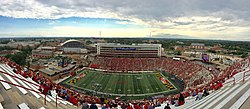The Shell | |
 Then-Maryland Stadium during a game on September 22, 2018 | |
 | |
| Former names | List
|
|---|---|
| Location | 90 Stadium Drive College Park, Maryland 20742 |
| Coordinates | 38°59′25″N 76°56′50″W / 38.99028°N 76.94722°W |
| Owner | University of Maryland, College Park |
| Operator | University of Maryland, College Park |
| Capacity | 51,802 (2012–present)[1]
Former capacity |
| Record attendance | 58,973 (1975 vs. Penn State)[5] |
| Surface | FieldTurf (2012–present) Grass (1950–2012) |
| Construction | |
| Broke ground | January 1949 |
| Opened | September 30, 1950[5] |
| Expanded | 1995, 2002, 2008 |
| Construction cost | US$1 million ($12.7 million in 2023 dollars[6]) |
| Architect | James R. Edmunds Jr.[7] Populous (renovations) |
| General contractor | Baltimore Contractors, Inc.[8] |
| Tenants | |
| Maryland Terrapins (NCAA) 1950–present Baltimore Stars (USFL) 1985 Presidential Cup Bowl (NCAA) 1950 | |
| Website | |
| umterps.com/secu-stadium | |
SECU Stadium[9] is an outdoor athletic stadium on the campus of the University of Maryland in College Park, Maryland. It is the home of Maryland Terrapins football and men's lacrosse teams, which compete in the Big Ten Conference. The facility was formerly named Byrd Stadium after Harry "Curley" Byrd, a multi-sport athlete, football coach, and university president in the first half of the 20th century, and temporarily Maryland Stadium after objections to Byrd's naming due to his history of supporting segregation.
- ^ "Maryland Football 2012 Preseason Notes" (PDF). University of Maryland Athletics. 2012. Retrieved September 10, 2013.
- ^ "2009 Maryland Football Spring Prospectus" (PDF). University of Maryland Athletics. 2009. Retrieved September 10, 2013.
- ^ "Maryland Football 2011 Preseason Notes" (PDF). University of Maryland Athletics. 2011. Retrieved September 10, 2013.
- ^ "2008 Football Game Notes - Maryland vs. No. 23 California" (PDF). University of Maryland Athletics. September 2008. Retrieved September 10, 2013.
- ^ a b "Capital One Field at Maryland Stadium". University of Maryland Athletics. Retrieved January 30, 2021.
- ^ 1634–1699: McCusker, J. J. (1997). How Much Is That in Real Money? A Historical Price Index for Use as a Deflator of Money Values in the Economy of the United States: Addenda et Corrigenda (PDF). American Antiquarian Society. 1700–1799: McCusker, J. J. (1992). How Much Is That in Real Money? A Historical Price Index for Use as a Deflator of Money Values in the Economy of the United States (PDF). American Antiquarian Society. 1800–present: Federal Reserve Bank of Minneapolis. "Consumer Price Index (estimate) 1800–". Retrieved February 29, 2024.
- ^ "Real Estate News". The Baltimore Sun. January 8, 1950. ProQuest 542045452. Retrieved September 29, 2011 – via ProQuest.
Edmunds... is working on plans for a field house for the university's new stadium...
- ^ "History - Baltimore Contractors LLC". Archived from the original on July 24, 2013.
- ^ "Maryland Athletics Announces Sweeping Partnership with SECU Credit Union of Maryland". University of Maryland Athletics. September 16, 2022. Retrieved September 16, 2022.


